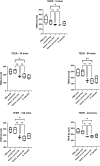Disruption of gut barrier integrity and host-microbiome interactions underlie MASLD severity in patients with type-2 diabetes mellitus
- PMID: 38235661
- PMCID: PMC10798360
- DOI: 10.1080/19490976.2024.2304157
Disruption of gut barrier integrity and host-microbiome interactions underlie MASLD severity in patients with type-2 diabetes mellitus
Abstract
Aberration of the "gut-liver axis" contributes to the development and progression of metabolic dysfunction-associated steatotic liver disease (MASLD). Here, we use multi-omics to analyze the gut microbiota composition and metabolic profile of patients with type-2 diabetes mellitus (T2DM). T2DM patients were screened for liver disease by blood tests, ultrasound, and liver stiffness measurements. Stool microbiota was analyzed by 16S rRNA gene sequencing; metabolomic profiling by Nuclear Magnetic Resonance spectroscopy and Ultra-High Performance-Mass Spectrometry. Microbiome and metabolic signatures were analyzed in the whole cohort and in matched subsets to identify signatures specific for steatosis (MASLD±) or fibrosis (Fibrosis±). Gut permeability was assessed in-vitro using monolayers of MDCK cells and trans-epithelial electric resistance (TEER). Cytokine profile was assessed in serum and stools.Overall, 285 patients were enrolled: 255 serum, 252 urine and 97 stool samples were analyzed. Anaeroplasma and Escherichia/Shigella ASVs were higher, while Butyricicoccus ASVs were lower in those with normal liver. In MASLD±, Butyricicoccus ASV was significantly higher in those with steatosis. In the Fibrosis±, Butyricicoccus ASV was significantly lower in those with fibrosis. Glycochenodeoxycholic acid-3-sulfate (G-UDCA-3S) appeared to be higher in MASLD with fibrosis. Fecal water from patients with MASLD and fibrosis caused the greatest drop in the TEER vs those with normal liver; this was reversed with protease inhibitors. Finally, fecal IL-13 was lower in MASLD with fibrosis. We identified microbiome signatures which were specific for steatosis and fibrosis and independent of other metabolic risk factors. Moreover, we conclude that protease-related gut permeability plays a role in those MASLD patients with fibrosis, and that disease progression is linked to a gut-liver axis which is at least partially independent of T2DM.
Keywords: MASLD; Microbiome; fibrosis; gut permeability; metabolomics; type-2 diabetes mellitus.
Conflict of interest statement
RL serves as a consultant to Aardvark Therapeutics, Altimmune, Anylam/Regeneron, Amgen, Arrowhead Pharmaceuticals, AstraZeneca, Bristol-Myer Squibb, CohBar, Eli Lilly, Galmed, Gilead, Glympse bio, Hightide, Inipharma, Intercept, Inventiva, Ionis, Janssen Inc., Madrigal, Metacrine, Inc., NGM Biopharmaceuticals, Novartis, Novo Nordisk, Merck, Pfizer, Sagimet, Theratechnologies, 89 bio, Terns Pharmaceuticals and Viking Therapeutics. RL has stock options in 89bio and Sagimet Biosciences. In addition his institutions received research grants from Arrowhead Pharmaceuticals, Astrazeneca, Boehringer-Ingelheim, Bristol-Myers Squibb, Eli Lilly, Galectin Therapeutics, Galmed Pharmaceuticals, Gilead, Hanmi, Intercept, Inventiva, Ionis, Janssen, Madrigal Pharmaceuticals, Merck, NGM Biopharmaceuticals, Novo Nordisk, Pfizer, Sonic Incytes and Terns Pharmaceuticals. Co-founder of LipoNexus Inc.
Figures



References
-
- Younossi Z, Stepanova M, Ong JP, Jacobson IM, Bugianesi E, Duseja A, Eguchi Y, Wong VW, Negro F, Yilmaz Y, et al. Nonalcoholic steatohepatitis is the fastest growing cause of hepatocellular carcinoma in liver transplant candidates. Clin Gastroenterol Hepatol. 2019;17(4):748–755.e3. doi: 10.1016/j.cgh.2018.05.057. published Online First: 2018/06/17. - DOI - PubMed
-
- Ekta Gupta E, Gupta M, Kaur A, Singh TG, Bedi O. Pathobiological and molecular connections involved in the high fructose and high fat diet induced diabetes associated nonalcoholic fatty liver disease. Inflamm Res. 2020;69(9):851–867. doi: 10.1007/s00011-020-01373-7. published Online First: 2020/06/23. - DOI - PubMed
-
- Bedi O, Aggarwal S, Trehanpati N, Ramakrishna G, Krishan P. Molecular and pathological events involved in the pathogenesis of diabetes-associated nonalcoholic fatty liver disease. J Clin Exp Hepatol. 2019;9(5):607–618. doi: 10.1016/j.jceh.2018.10.004. published Online First: 2018/11/12. - DOI - PMC - PubMed
Publication types
MeSH terms
Substances
Grants and funding
LinkOut - more resources
Full Text Sources
Medical
